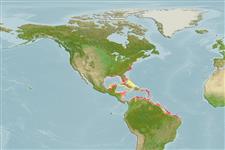>
Tetraodontiformes (Puffers and filefishes) >
Diodontidae (Porcupinefishes (burrfishes))
Etymology: Chilomycterus: Greek, cheilos = lip + Greek, mykter, -eros = nose (Ref. 45335).
More on author: Walbaum.
Environment: milieu / climate zone / depth range / distribution range
Écologie
marin récifal; profondeur 1 - 11 m (Ref. 9710). Tropical; 46°N - 5°S, 98°W - 34°W
Western Atlantic: Nova Scotia (Canada), Maine (USA), Bahamas, and northern Gulf of Mexico to Brazil. Uncommon or absent from most of West Indies.
Taille / Poids / Âge
Maturity: Lm ? range ? - ? cm
Max length : 27.9 cm TL mâle / non sexé; (Ref. 40637); poids max. publié: 630.00 g (Ref. 4699)
No spines wholly on caudal peduncle. Supraocular tentacles absent or much smaller than eyes. 5 to 7 large dark blotches on back and sides, with many, approximately parallel to obliquely intersecting dark lines distributed over light background colour. No small, dark spots either on body or fin (Ref 53034).
Very common in seagrass beds in bays and coastal lagoons. Also found on shallow coastal reefs (Ref. 9710). Has been traded as an aquarium fish at Ceará, Brazil (Ref. 49392).
Life cycle and mating behavior
Maturité | Reproduction | Frai | Œufs | Fécondité | Larves
Robins, C.R. and G.C. Ray, 1986. A field guide to Atlantic coast fishes of North America. Houghton Mifflin Company, Boston, U.S.A. 354 p. (Ref. 7251)
Statut dans la liste rouge de l'IUCN (Ref. 130435)
Menace pour l'homme
Harmless
Utilisations par l'homme
Pêcheries: sans intérêt; pêche sportive: oui; Aquarium: Commercial
Plus d'informations
Noms communsSynonymesMétabolismePrédateursÉcotoxicologieReproductionMaturitéFraiRassemblement de ponteFéconditéŒufsDéveloppement de l'œuf
RéférencesAquacultureProfil d'aquacultureSouchesGénétiqueElectrophoresesHéritabilitéPathologiesTraitementNutrientsMass conversion
Outils
Articles particuliers
Télécharger en XML
Sources Internet
Estimates based on models
Preferred temperature (Ref.
123201): 18.4 - 28, mean 26.9 °C (based on 501 cells).
Phylogenetic diversity index (Ref.
82804): PD
50 = 0.5313 [Uniqueness, from 0.5 = low to 2.0 = high].
Bayesian length-weight: a=0.04786 (0.01967 - 0.11644), b=2.82 (2.61 - 3.03), in cm total length, based on LWR estimates for this (Sub)family-body shape (Ref.
93245).
Niveau trophique (Ref.
69278): 3.5 ±0.37 se; based on food items.
Résilience (Ref.
120179): Haut, temps minimum de doublement de population inférieur à 15 mois (Preliminary K or Fecundity.).
Fishing Vulnerability (Ref.
59153): Low vulnerability (18 of 100).
Nutrients (Ref.
124155): Calcium = 52 [22, 127] mg/100g; Iron = 0.646 [0.310, 1.460] mg/100g; Protein = 18.4 [16.2, 20.5] %; Omega3 = 0.1 [0.1, 0.2] g/100g; Selenium = 26.3 [13.2, 55.5] μg/100g; VitaminA = 58.8 [17.0, 209.9] μg/100g; Zinc = 1.19 [0.79, 1.80] mg/100g (wet weight);
